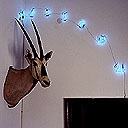Perhaps a more typical case is a student at Yale's art school whom I met a few years ago. He was spending his days trying to figure out how to wire bars of ivory soap together so that he could make a vessel, float it in a tank, and film it as it dissolved. His art was more didactic than Hirst's. The boat, he insisted, would symbolize the slave trade, and thus his installation was making a statement about slavery. Didactic, but not profound -- for after talking to him about his project I concluded while he was good at devising a clever way to make a statement he did not have anything particularly interesting to say. Moreover, I know that I would not have a clue what his art was about if I saw it in a gallery if it were not for some long manifesto or explanatory text posted nearby. While I usually appreciate the additional information and carefully read the placards even when I know the art well, I resent being utterly dependent on them as I often am with installation art.
The Arte Povera show has its fair share of the opaque and the obscure. Several installations make uninteresting political statements, although I suppose these may be of some significance to those interested in cold-war Italian culture. Many other pieces fall into the category of art that uses unusual materials for the sake of challenging convention, the most amusing of which involve refrigerators. I had to remind myself that these works were almost forty years old; although they seemed quaint to me they were in fact revolutionary and exciting when they were produced. The artists of the Arte Povera movement were genuine innovators who raised important and original questions about artistic conventions, though the revolution now seems a bit dated.
Many of the Arte Povera works fall prey to the problems associated with
intellectualism of installation art. Mario Merz, for example, put together
an installation consisting of blue neon numbers
 together with ten photographs of factory workers eating in their cafeteria, the first picture with one worker, the next with several, and so forth until the final picture showed a crowd. It made no sense whatsoever until I read the signs that explained Merz's fascination with the Fibonacci sequence, which for Merz references "organic creation." Neon, the signs went on, "alludes to the continuous flow of energy between objects as well as in and around the earth." All of this Merz contrasts with industrial existence and social organization, represented by the factory workers. Now, I understand that Merz has a particular view of the universe that I suppose may be moderately interesting, , but rather than express that view to me or enable me to see the world as he does, all he accomplishes is a solipsistic monument to his interests. He is inviting me to acknowledge his thing for mathematical sequences rather than involve me in his vision. Not only did I not 'get' his art until I read the explanatory signs, but once I 'got it' I was not interested, and certainly not inspired.
together with ten photographs of factory workers eating in their cafeteria, the first picture with one worker, the next with several, and so forth until the final picture showed a crowd. It made no sense whatsoever until I read the signs that explained Merz's fascination with the Fibonacci sequence, which for Merz references "organic creation." Neon, the signs went on, "alludes to the continuous flow of energy between objects as well as in and around the earth." All of this Merz contrasts with industrial existence and social organization, represented by the factory workers. Now, I understand that Merz has a particular view of the universe that I suppose may be moderately interesting, , but rather than express that view to me or enable me to see the world as he does, all he accomplishes is a solipsistic monument to his interests. He is inviting me to acknowledge his thing for mathematical sequences rather than involve me in his vision. Not only did I not 'get' his art until I read the explanatory signs, but once I 'got it' I was not interested, and certainly not inspired.



film politics music jay's head poetry art josh ring fysche saddies about archive